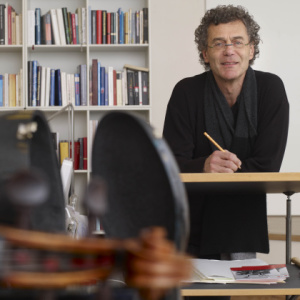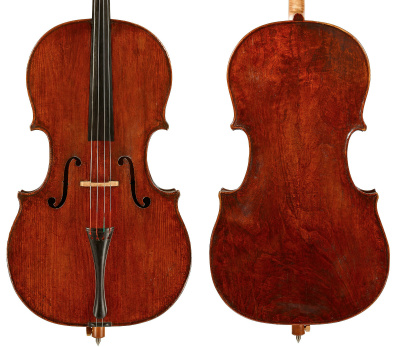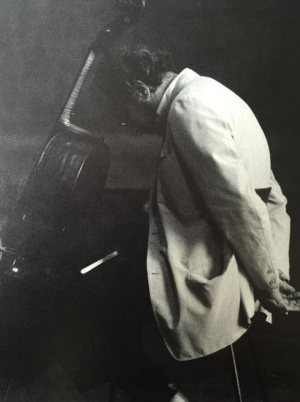
Thomas Demenga: ‘Everyone sounds different on the same instrument.’ Photo: Priska Ketterer Luzern
The first time Thomas Demenga played his Guarneri cello was while he was in London to perform the Bach Suites at Wigmore Hall in 2013. Although he was already in love with one instrument – his 1595 Brothers Amati – he fell in love with the Guarneri immediately: ‘I knew when I picked it up that I wanted to buy it if I could.’ But he had a concert to perform and gave the instrument back. ‘I didn’t want to spend too much time on it and had to concentrate on the concert. That was my first encounter with it and it stayed in my mind.’
Yet the first time Demenga had actually heard the cello was nearly five decades earlier, as a teenager: ‘I was living in Bern when the Guarneri Quartet came to perform, and David Soyer played this cello. I’d never heard a cello or cellist like it before. This huge, physically imposing man played with no effort and the sound was incredible. That was the point I knew I wanted to be a professional cellist.’
When the opportunity arose for Demenga to buy the cello through Tarisio, it was a dream come true. Does he feel Soyer’s presence in the instrument? ‘David Soyer is a legend to me. That was the first fantastic experience I had with a string quartet. Subsequently, when I was studying in New York, the Guarneris performed the complete Beethoven quartets. I went to each concert and it was wonderful to hear him again. I was a fan of the quartet, so the whole story gives me joy and respect for this cello. But the quality of the instrument has nothing to do with David Soyer. It’s my sound I’m creating. Everyone sounds different on the same instrument. How you produce the sound, what makes that sound yours; that’s not the cello, it’s you.’

When the teenage Demenga first heard David Soyer playing the Andrea Guarneri he was instantly fascinated by its sound
Demenga describes the Guarneri as having a directness of sound that immediately attracted him. ‘It’s a round, deep, earthy sound, nothing like the direct metallic sound that so many of today’s players prefer. That is what fascinated me right away. With an instrument, you pick it up and it works for you, but it’s rare that you don’t think “there’s a wolf here”, “that note doesn’t speak”, “I would like more edge” and so forth. Seldom have I picked up a cello and not had anything to complain about. With this instrument I was happy right away. It was a very intense experience.’
Has the cello had to adjust from being mainly a quartet instrument to conveying concertos and solo recitals? ‘I don’t know whether you can tell that an instrument has a memory like that. Maybe the A string felt a bit unsoloistic at first, but the lower part of the cello was what fascinated me more. You could argue that if you mainly use it in the bass register it will develop those frequencies more intensely than playing high on the A string, but since I have changed the bridge I get a little more punch on the A string and it’s become brighter.’
Demenga sold his Amati in order to buy the Guarneri. How did he find the difference between the instruments? ‘The Guarneri has a clearer sound: direct, yet warm and round. The Amati has more of a Strad quality in the sense that there are more things going on around the sound, on each string. Maybe what made me prefer the Guarneri finally was the clarity, even without a Belgian bridge, which usually helps with that. It has a normal French bridge and it has a large sound, not thin like a laser beam but with a lot of width. The Amati has a more noble sound and a fantastic bass, but it doesn’t have that crystal-clear sound. That’s the main difference.’

David Soyer, former cellist of the Guarneri Quartet. Photo: Dorothea von Haeften
This meant he didn’t radically have to alter his way of playing, although he has made adaptations: ‘I can play nearer the bridge. With the Amati I had to be careful not to go too close – I needed more speed of bow and less pressure. It sounded incredibly well like that but when you started pressing it wouldn’t produce a more direct quality or bigger volume. Many of the great instruments I’ve played sound best with a lot of speed – Strads are like that. This Guarneri takes both speed and pressure, and you can go really close to the bridge without choking the sound. With the Amati I developed a style of playing that was a bit lighter, just using the bow to release the cello sound, which is also a beautiful experience.’
Another crucial aspect Demenga appreciates is its evenness, which he realised when fellow cellist Pieter Wispelwey tried out the Guarneri: ‘He played a long chromatic scale from the open C to the top and he discovered that there’s not one note that sounds less or more. It’s completely even over the whole range of the cello, and that’s what you feel immediately when you pick it up. It’s like a piano – each sound has the same quality and nothing sticks out.’
There is one problem with the Guarneri, says Demenga, but a very human one: ‘When I get up in the morning I have to play it a bit until it wakes up. There’s something strange about that, but I never know if it’s me or the cello. I think we meld together with our instruments. I do, anyway: the least thing that goes wrong or doesn’t work well shows in my mood. I feel just as sick as the cello if it doesn’t work well.’
Formerly editor of The Strad magazine, Ariane Todes is now a freelance writer and editor.